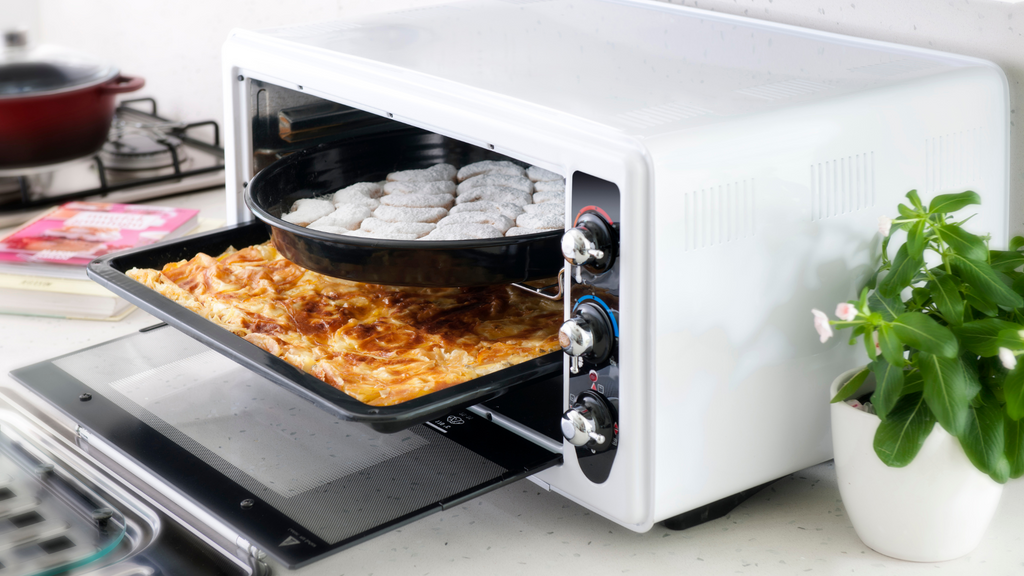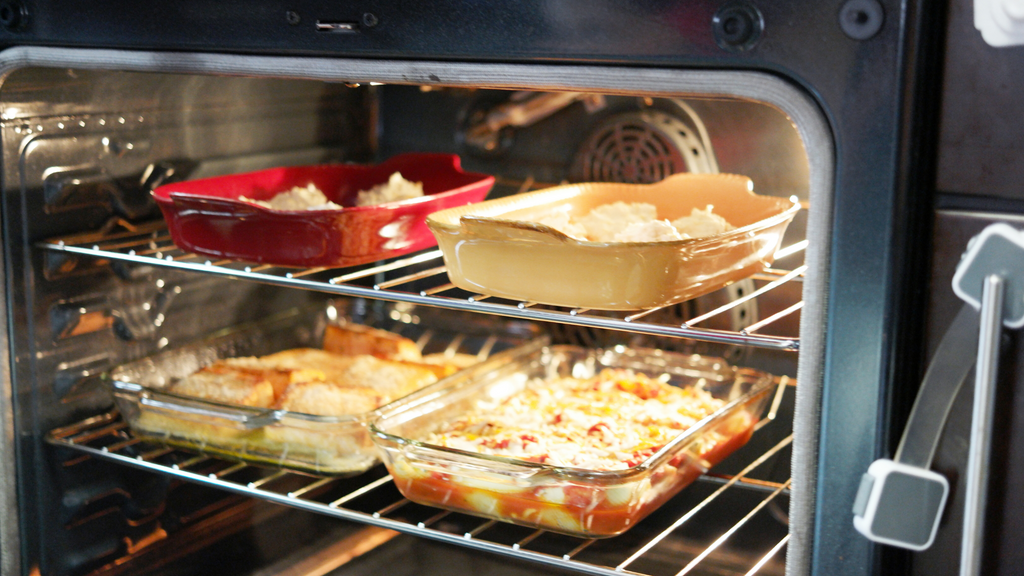The ever-mysterious convection oven—a phrase that tends to make even seasoned home cooks scratch their heads. We’ve all been there: You’re leafing through a trendy new cookbook or scrolling through a food blog, and the recipe says, "If using a convection oven, adjust the time and temperature."
Suddenly, you feel like you've stumbled into some elite cooking club you're not a part of. But guess what? Understanding the convection oven meaning is like learning a secret handshake—it’s an insider tip that can significantly elevate your culinary prowess.
So why the buzz around convection ovens? For starters, they're not just a "nice-to-have" but increasingly becoming a "must-have" in modern households. We're talking about faster cooking times, even browning, and, yes, a legit excuse to host that dinner party you've been dreaming about.
In an age where we're all about optimising, from our phone apps to our fitness routines, isn't it time we gave our kitchens the same 21st-century treatment?
So, if you've ever asked yourself, "Do I need a convection oven?" or found yourself intrigued by its function, stay with me. We're about to unveil the mystery of its modern cooking technology and reveal why this kitchen essential might just be the missing ingredient in your culinary adventures. Trust me; it's a game-changer you'll want to know about.
What Does “Convection Oven” Really Mean?

At its core, the convection oven is all about air—hot air, to be exact. It circulates hot air throughout the oven using a fan. That's the technology behind it. It’s like having a tiny, invisible kitchen assistant waving hot air inside to ensure your cookies are golden perfection, not a baking sheet of disappointment.
This technology ensures that every inch of your culinary masterpiece gets the love and heat it deserves.
How Do Convection Ovens Differ from Traditional Ovens?
Let's break down the difference between convection ovens and traditional ovens:
|
Feature |
Traditional Ovens |
Convection Ovens |
|
Heating Elements |
Either bottom or both top and bottom elements to generate heat. |
Heating elements plus a fan for hot air circulation. |
|
Cooking Efficiency |
Good enough but can lead to uneven cooking. |
High efficiency; can cut roasting time by up to 25%. |
|
Air Circulation |
Minimal; hot spots can lead to uneven cooking. |
Excellent; the fan circulates hot air for uniform cooking. |
|
Common Problems |
One side of a dish may be crispier than the other. |
Rarely any, thanks to even cooking. |
|
Baking Results |
Risk of "soggy bottom" pies or unevenly cooked baked goods. |
Consistent, even baking that could make you a contender on the Great British Bake Off. |
|
Time Management |
May require more time and attention, including rotating pans. |
More free time for other activities due to quicker, more efficient cooking. |
Top Uses for Your Convection Oven

Let’s explore the top convection oven uses that’ll have you cooking like a Food Network star in no time.
Baking: The Fluff is Real
Your convection oven uses a fan to circulate air, meaning your baked goods rise higher, cook more evenly, and taste better.
Pro Tip: For an extra-fluffy chiffon cake, lower the oven's temperature by 25°F to avoid the outer layer getting too crispy too soon.
Roasting: Crisp Outside, Juicy Inside
There's something magical about biting into a piece of crispy chicken on the outside and juicy on the inside, and that's what you get when you roast with a convection oven. Say hello to a new world of perfectly roasted meats and vegetables.
Hack Alert: Place the meat on a roasting rack to up your roasting game. This allows the circulating air to reach all sides of the dish, resulting in a gorgeous, even sear.
Dehydrating: Snack Game Strong
We’re talking beef jerky, dried fruits, and even those fancy veggie chips. Your convection oven's circulating air speeds up the drying process, making it super convenient for dehydrating.
Personal Tip: Use parchment paper to line the oven racks for an easier cleanup.
Broiling: Charred to Perfection
You can get that grilled flavour without stepping foot outside.
Quick Hack: Broil fish skin-side up to get that perfect, restaurant-quality crispy skin.
Why the Convection Oven is a Smart Buy?
Energy Efficiency:
Due to its hot-air-circulating mojo, a convection oven needs less time to do the same jo. Less cooking time equals less electricity. So it's a culinary powerhouse and your own Earth Day celebration.
Bonus Point: Did you know it can be more cost-effective in the long run because it cooks faster?
Time-Saving:
A convection oven's quick and even cooking nature means you get your life back one saved minute at a time.
Quick Hack: Pop in a pizza and a tray of cookies simultaneously. The convection setting ensures even cooking for both.
Factors to Consider: Choosing the Right Model

Size Does Matter
The size of your oven should fit the space in your kitchen and your lifestyle. Going mini won't cut it if you’re feeding a family of six. Conversely, a colossal oven is just overkill if you're a city-dwelling, studio-apartment-loving individual.
Pro Tip: Measure the space where the oven will go. Twice. There's nothing worse than realising your new culinary best friend is too big to fit in its designated corner.
Features:
Some models come with programmable settings, others have Steam options, and others even connect to your smartphone.
Know-How: Look for models with dual fans for super-efficient air circulation, especially if you're all about that baking life.
Brand:
While the brand isn't everything, it can be something. Companies with a track record for durability and customer service can provide peace of mind. But don’t be afraid to go off the beaten path; new brands can offer innovative features that the veterans haven't tapped into yet.
Quick Note: Check out customer reviews, but remember, people are likelier to report a bad experience than a good one.
How Much Should You Expect to Pay? Convection Oven Price Guide
Price Range Real Talk
Convection ovens can cost anywhere from a modest $250 to a mind-boggling $4,000 or more. You do get what you pay for. You’ll find decent options for everyday cooking tasks on the lower end. But if you’re looking for a kitchen sidekick who sings, dances, and organises your life, be prepared to shell out some serious dough.
Reality Check: Always consider it as an investment. Think long-term value for money rather than a one-time expense.
What's Pumping Up the Price?
Material: Stainless steel costs more than enamel, for instance.
Features: Smartphone compatibility, built-in recipes, and other bells and whistles can up the ante.
Brand: Established brands can command higher prices because, well, they’ve been around the block, and they know they’re worth it.
Insider’s Tip: Seasonal sales and promotions can make even the priciest models more attainable. Set up price alerts and stay on the lookout for deals.
Is it Worth It?
If you pick the right one, you'll probably wonder how you ever lived without it. Look for the features you’ll use and the size that fits your space and lifestyle, and you won’t regret a single penny spent.
Wrapping It Up: Is a Convection Oven Right for You?
Key Takeaways: Your Cheat Sheet
Price Range: Remember, a convection oven can fit many budgets, but you'll get what you pay for.
Features: From the basic to the bedazzling, features matter—Prioritise based on your needs.
Lifestyle Fit: Size, efficiency, and the cooking types you indulge in should be front and centre in your decision-making process.
Final Thoughts: It's more than just an appliance; it’s a lifestyle upgrade.
The Lifestyle Fit: Is It You?
The Busy Bee: If you’re all about that hustle and always short on time, the efficiency of a convection oven might just be your new best friend.
The Culinary Adventurer: Love to experiment? A convection oven offers a vast playground for your culinary adventures.
The Home Entertainer: If your home is the go-to spot for dinner parties or Sunday brunch, a convection oven's cooking efficiency and versatility will help you quickly serve crowd-pleasers.
Pro Insight: The real beauty of a convection oven lies in its adaptability. It’s not about whether you cook three meals a day or three meals a month; it’s about how you want those meals to turn out.
Your Quick Hit Guide:
Deciding on a kitchen appliance isn't just about ticking boxes; it's about choosing something that fits your daily life. You want that oven to be the unsung hero of your kitchen. Am I right? So, if you're leaning towards saying 'yes' to a convection oven, I've got just the place for you to seal the deal: Megafurniture.
Essential Reads For You:
"Interior Design Singapore: Best Firms for Your Next Home Renovation."
"Your Ultimate Cheat Sheet to Renovation in Singapore: HDB Guidelines, Procedures & Tips,"
Bonus Treat: "Convection Oven Sambal Chicken Roast: A Singaporean Spice Fusion for the Holidays"

Ingredients:
- 1 whole chicken (about 1.5kg)
- 3 tablespoons of sambal paste (store-bought or homemade)
- 2 tablespoons of olive oil
- Juice of 1 lime
- 2 teaspoons of turmeric powder
- 3 cloves of garlic, minced
- Salt to taste
- 1 sprig of fresh coriander for garnish (optional)
Instructions:
- Clean the chicken well, remove any innards, and pat it dry with paper towels.
- Combine the sambal paste, olive oil, lime juice, turmeric, minced garlic, and salt in a bowl. Mix well.
- Generously rub the sambal marinade all over the chicken and inside the cavity. Allow it to marinate for at least 3 hours or overnight for best results.
- Set the oven to 180°C (356°F).
- Place the chicken breast-side up on a roasting rack within a roasting pan.
- Put the pan in the oven and roast for about 60-75 minutes. Your convection oven will ensure that the chicken is cooked evenly.
- The chicken should reach an internal temperature of at least 165°F (75°C). Also, the juices should run clear when you cut between a leg and thigh.
- Once cooked, remove the chicken from the oven and let it rest for 10 minutes. This allows the juices to redistribute throughout the meat. Garnish with fresh coriander if desired.
- Carve the chicken into serving pieces and enjoy your Sambal Chicken Roast with family and friends!








